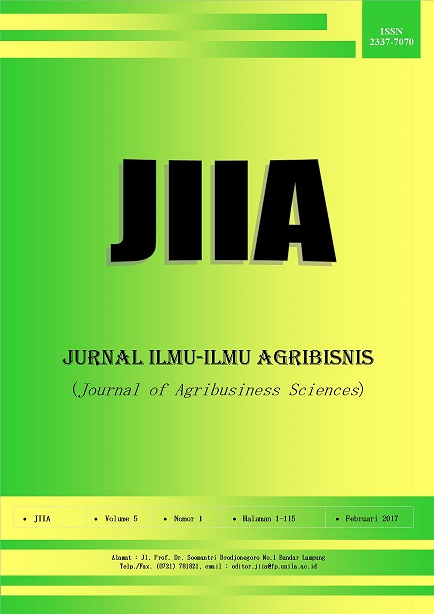ANALISIS USAHATANI DAN EFISIENSI PEMASARAN KOPI (Coffea sp) DI KECAMATAN PULAU PANGGUNG KABUPATEN TANGGAMUS
DOI:
https://doi.org/10.23960/jiia.v5i1.1668 Abstract View: 2844
Abstract View: 2844
Abstract
This research aims to know the coffee farming, the formation process of coffee prices at farmer level, the coffee marketing channels, and marketing efficiency of coffee in Pulau Panggung subdistrict of Tanggamus Regency. This research was conducted in Gunung Megang village and Sri Mengantin village by involving 66 coffee farmers and following the flow of marketing, namely traders and trade collectors. Data analysis methods used in this research are a qualitative descriptive analysis and quantitative descriptive analysis including business farming (R/C ratio) and the S-C-P (Structure, Conduct, dan Perfomance) to analyze the organization of the market. The results showed that R/C ratio of >1, meaning that the farming of coffee was worthy to be cultivated and gave benefit. Farmers did not apply hedging system for their products. The coffee marketing channels in Pulau Panggung sub district of Tanggamus regency was as the following: farmers – large trader merchants– collectors – exporters. The marketing of coffee in Pulau Panggung sub district of Tanggamus Regency was not efficient, although the producer share reached more than 80%, the ratio of profit margin (RPM) on every marketing institution did not spread evenly.
Key words: coffee, efficiency, farming, marketing
Downloads
Downloads
Published
How to Cite
Issue
Section
License
Authors who publish with this journal agree to the following terms:
Authors retain copyright and grant the journal right of first publication with the work simultaneously licensed under a Creative Commons Attribution License that allows others to share the work with an acknowledgement of the work's authorship and initial publication in this journal.
Authors are able to enter into separate, additional contractual arrangements for the non-exclusive distribution of the journal's published version of the work (e.g., post it to an institutional repository or publish it in a book), with an acknowledgement of its initial publication in this journal.
Authors are permitted and encouraged to post their work online (e.g., in institutional repositories or on their website) prior to and during the submission process, as it can lead to productive exchanges, as well as earlier and greater citation of published work (See The Effect of Open Access).














